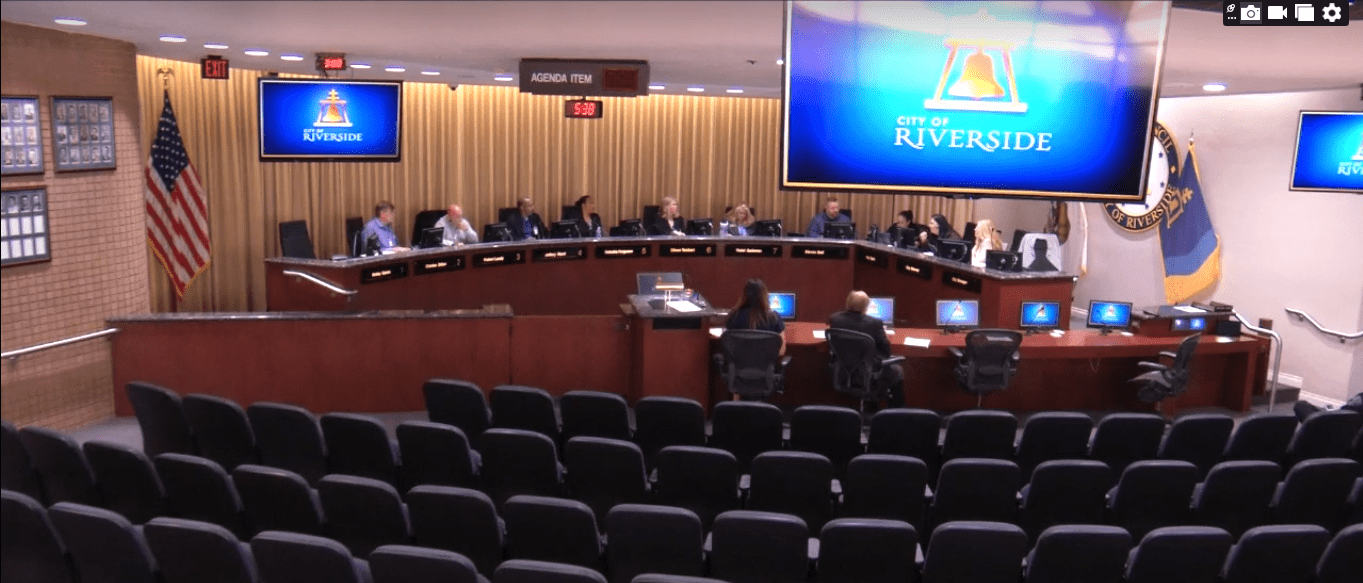Riverside, CA — The May 28 meeting of the Riverside Community Police Review Commission (CPRC) revealed growing concerns over racial disparities in police stops, the limited use of body-worn cameras and a lack of access to critical evidence in officer-involved death cases.
As part of Inland Valley News’s ongoing “Watches the Watchmen” series, this latest installment follows commissioners as they grapple with recent Racial and Identity Profiling Act (RIPA) data and attempt to hold police accountable in a fatal shooting involving a Riverside detective who was not wearing a body camera.
Ruby Castillo from the city manager’s office presented findings from the 2024 and 2025 RIPA reports, revealing patterns consistent with previous years: people of color, particularly Black and Latiné residents, are disproportionately stopped by Riverside police.
According to Castillo’s presentation, while Latiné individuals make up 55.9% of Riverside’s population, they represented 52.7% of all stops in 2025, up from 48.9% the year prior.
Black residents, however, accounted for 6.6% of the population but 14.5% of police stops, indicating a stop rate more than twice their demographic proportion.
“I was just curious about the comparison of the population percentage versus the percentage of stops,” Commissioner Jeffery Ward said. “Some of them look to be significantly larger than the population, and that stood out to me.”
Castillo acknowledged these disparities but offered no immediate policy remedy.
She explained that while the state’s RIPA advisory board provides recommendations for local reform, there is no mandate for agencies to act on them.
RIPA data is collected under Assembly Bill (AB) 953, passed in 2015 to combat racial and identity profiling.
The law requires officers to report perceived race, gender and reasons for stops, but gaps remain.
Officers’ subjective perceptions still shape the dataset, and stops outside city limits—where officers may be commuting—are excluded from local analysis, limiting its precision.
The CPRC agreed to file the report but may revisit it to develop policy recommendations aimed at reducing unnecessary stops.
Later in the meeting, commissioners discussed a 2022 officer-involved shooting in Hemet involving a Riverside Police Department detective assigned to the Riverside County District Attorney’s Office Gang Impact Team which also included officers from the Hemet Police Department and the Riverside County Sheriff’s Office.
The detective fatally shot a suspect—identified as Joseph Tracy IV—but had no body-worn camera on at the time, according to CPRC consultant Frank Hauptmann.
“This officer did not have a body camera,” Hauptmann told commissioners. “The [Riverside Police] Department reviewed this, but there was no citizen complaint, so we were not provided with the internal administrative findings.”
While surveillance video and body-worn camera footage from at least one of the other involved officers has been released, this gap in video evidence prompted commissioners to unanimously vote to invoke the rarely used power to issue subpoenas.
“We’ve essentially been hamstrung,” said Commissioner Violet L. Gutierrez. “We need to see what happened between those cars—whether the shooting was justified.”
Hauptmann confirmed that subpoenas would take approximately 20 to 30 days to yield records and noted this would be the first time in over a decade that the CPRC exercised its subpoena power.
Commissioners further discussed the limited scope of their oversight authority. Despite being a chartered commission, they cannot access internal disciplinary records without a formal citizen complaint.
Deputy Chief Charles Payne reminded commissioners of optional ride-alongs and sit-alongs with dispatchers, saying, “You’ll get a very different perspective on how some of these incidents originate.”
He also acknowledged May as Law Enforcement Memorial Month and said officers were wearing subdued uniforms to honor fallen colleagues.
But as CPRC Chair Bell noted, the commission’s job is to ensure accountability, not just perspective.
The commission voted to move into the next stages of its review of the 2022 shooting. As subpoena responses are awaited, the CPRC aims to determine whether the officer’s use of force adhered to department policy and legal standards.
The next CPRC meeting is scheduled for June 25, 2025.









